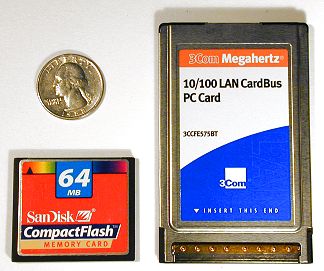[ The PC Guide | Systems and Components Reference Guide | Hard Disk Drives | Construction and Operation of the Hard Disk | Hard Disk Form Factors ]
PC Card (PCMCIA) Form Factor
One of the most popular interfaces used in the notebook PC world is the PC Card interface, also sometimes called PCMCIA after the group that created it in the late 1980s. This interface standard was created to allow for easier expansion of notebook systems, which at that time had very few options for adding hardware at all. For information on the PC Card interface as it relates to hard disks, see this page.
Despite the relatively small size of cards that adhere to the PC Card standard, hard disk engineers have managed to create hard disks to fit. There are actually three PC Card form factor sizes, defined by the PCMCIA in 1995. The width and depth of these devices is exactly the same as that of a credit card, which I am sure is not a coincidence! They are all 2.13" wide and 3.37" deep. The three sizes differ only in their height. Type I devices are 3.3 mm thick; Type II devices are 5.0 mm thick, and Type III devices are 10.5 mm thick. Originally, the intention was for solid state devices like memory, modems and the like to use the Type I and Type II devices, while the Type III devices were for hard disks. Due to the extreme height limits of PC Cards, it is difficult to make hard disks that will fit into the allowed space, and most PC Card hard disks are Type III. However, advances in miniaturization have allowed some companies to now make hard disks that actually fit into the Type II PC Card form factor as well. Since most laptops can only accept either two Type I/II cards or a single Type III, this is a significant advantage. Here's a summary table of the different sizes:
Form Factor |
Width (in) |
Depth (in) |
Height (in/mm) |
Application |
PC Card Type I |
2.13 |
3.37 |
0.13 / 3.3 |
Not used for hard disks (yet?) |
PC Card Type II |
2.13 |
3.37 |
0.20 / 5.0 |
Smaller-capacity expansion hard disks for laptops and consumer electronics |
PC Card Type III |
2.13 |
3.37 |
0.41 / 10.5 |
Higher-capacity expansion hard disks for laptops |
The 2.13" width of this form factor puts a hard limit on the platter size of these drives--even 2.5" platters are too large. Most PC Card drives today use 1.8" platters. Interestingly, the first hard drive to use the PC Card form factor was probably the Hewlett Packard Kittyhawk drive, with much smaller 1.3" platters. This drive is a good example of a technology being "ahead of its time". It was actually introduced way back in 1992, very early on for such miniaturized technology. Unfortunately, at the time the market may not have been big enough to provide HP with sufficient revenues to keep making it. The Kittyhawk was used in early hand-helds and other small consumer electronic devices (even printers!) for a while, but was eventually discontinued, and HP is no longer making hard disk drives of any sort. If this technology had been introduced five years later, it may have been a runaway success; certainly IBM is having great success with its slightly-smaller Microdrive.
|
A CompactFlash card (left) and a PC Card (right). |
![]() Note: Many companies also
make "solid state drives" using the PC Card form factor. These perform the same
function as hard disk drives, but are not hard disks at all: they are actually flash
memory, a type of ROM. I discuss this in more detail
in the section on the CompactFlash form factor.
Note: Many companies also
make "solid state drives" using the PC Card form factor. These perform the same
function as hard disk drives, but are not hard disks at all: they are actually flash
memory, a type of ROM. I discuss this in more detail
in the section on the CompactFlash form factor.
Interestingly, with a couple of exceptions, most of the smaller PC Card hard disks are not made by the bigger, well-known hard disk companies, but rather smaller niche companies. I am not sure what the reason is for this. I suspect that there just may not be enough profit potential there for the big names to bother with this market, which is small compared to the market for mainstream PC drives.
![]() Next: CompactFlash
Form Factor
Next: CompactFlash
Form Factor
| The PC Guide
(http://www.PCGuide.com) Site Version: 2.2.0 - Version Date: April 17, 2001 © Copyright 1997-2004 Charles M. Kozierok. All Rights Reserved. |
Not responsible for any loss resulting from the use of this site. Please read the Site Guide before using this material. |
